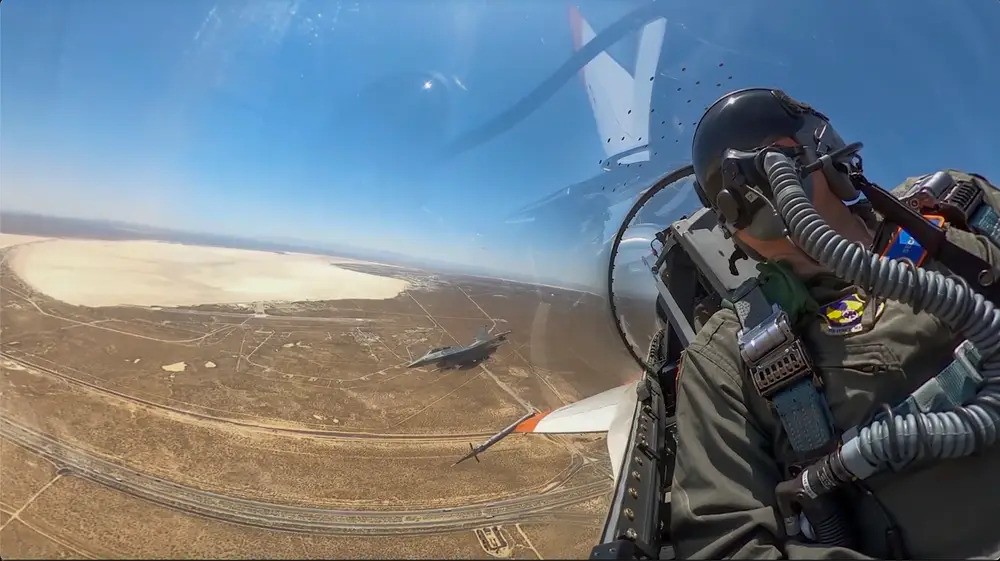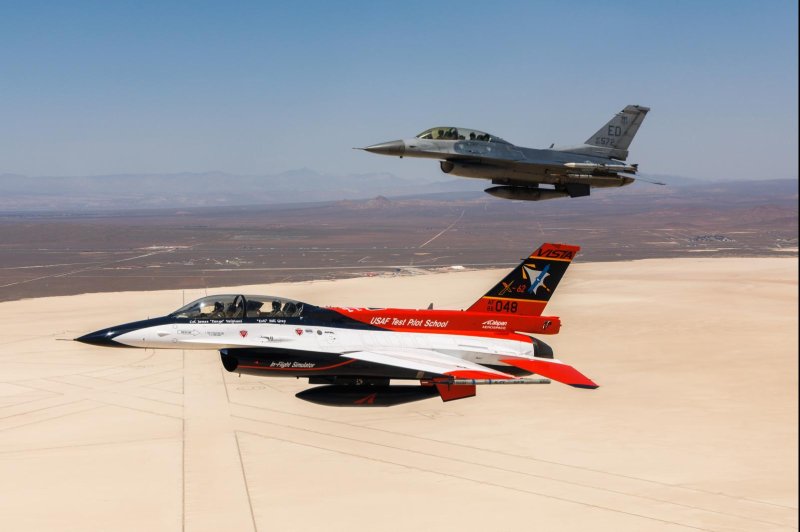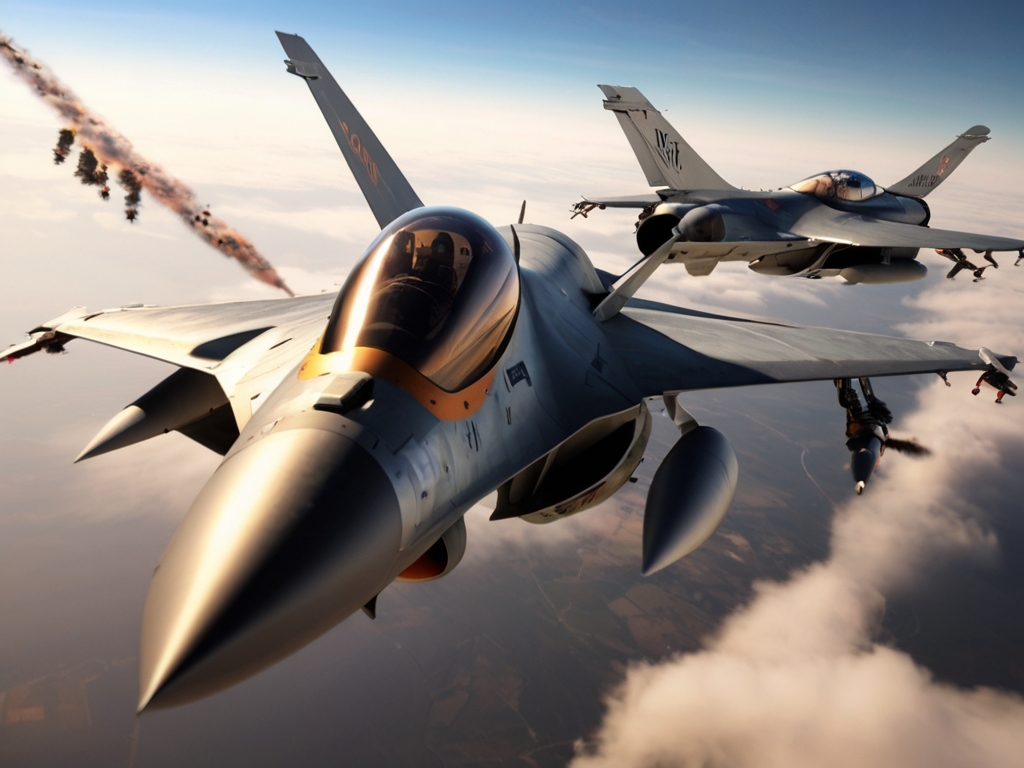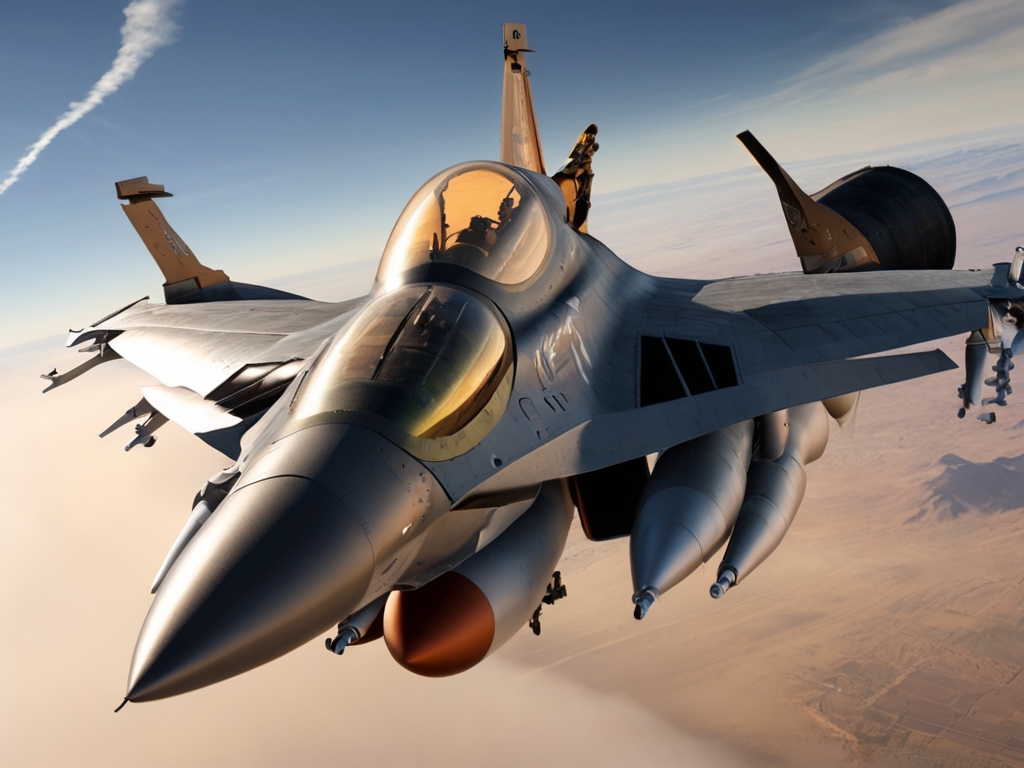In the vast expanse of the Californian desert, a historic event unfolded, heralding a paradigm shift in military aviation for the U.S. Air Force. As the midday sun blazed overhead, an experimental orange and white F-16 fighter jet thundered into the skies above Edwards Air Force Base. But this was no ordinary flight; the aircraft was controlled not by a human pilot, but by an artificial intelligence (AI) system, a technological marvel that has captivated the imagination of defense strategists and futurists alike.
Strapped into the front seat of this AI-piloted F-16, dubbed the Vista, was none other than Frank Kendall, the Secretary of the United States Air Force. With a grin etched across his face, Kendall emerged from the cockpit, having experienced firsthand the exhilarating potential of AI in aerial combat. “It’s a security risk not to have it. At this point, we have to have it,” he declared, his words resonating with the gravity of a pivotal moment in military history.

The Transformative Power of AI in Air Superiority
The integration of AI into the legendary F-16 fighter represents a seismic shift in the U.S. Air Force’s pursuit of air superiority, a concept that has long been a cornerstone of military strategy. Throughout history, the ability to control the skies has proven pivotal in determining the outcome of conflicts, granting nations a decisive edge over their adversaries.
In the modern era, the advent of AI promises to redefine the very essence of aerial combat for the U.S. Air Force. AI-enhanced F-16s boast the ability to process vast amounts of data at lightning speeds, synthesizing information from multiple sensors and making split-second decisions with a level of precision that surpasses human capabilities. This advantage is invaluable in the high-stakes realm of air-to-air combat, where milliseconds can mean the difference between victory and defeat.
As witnessed during Kendall’s flight, the AI-controlled Vista executed dizzying maneuvers at speeds exceeding 550 miles per hour, subjecting his body to forces five times greater than Earth’s gravity. In a simulated dogfight, the AI F-16 engaged in a breathtaking display of aerial mastery, twisting and looping within a mere 1,000 feet of a human-piloted counterpart, probing for vulnerabilities and exploiting every tactical advantage.
Strategic Imperatives and the Quest for Technological Superiority
The U.S. Air Force’s pursuit of AI air superiority transcends mere technological prowess; it is a strategic imperative as the United States grapples with the rise of near-peer adversaries and the ever-evolving nature of warfare. China’s rapid military modernization, coupled with its burgeoning fleet of unmanned aerial vehicles (UAVs) and advanced air defense systems, presents a formidable challenge to American air dominance.
The integration of AI-enhanced F-16s could prove pivotal in countering this threat, enabling the United States to project power and maintain a credible deterrent against potential aggression. Moreover, it aligns with the broader strategic vision of the Department of Defense (DoD), which has placed a strong emphasis on the development and deployment of autonomous systems across all domains of warfare.

Yet, the strategic implications extend beyond offense and deterrence. The ability to conduct precise, surgical strikes with minimal collateral damage could reshape conflict resolution, reducing human casualties and mitigating the risk of escalation. Furthermore, the data-driven decision-making capabilities of AI systems could enhance situational awareness and intelligence gathering, enabling more informed operational planning and agile decision-making for the U.S. Air Force.
Ethical Concerns and the Quest for Responsible AI Governance
Despite the allure of technological superiority, the integration of AI into the iconic F-16 fighter has ignited a firestorm of ethical and moral debates. At the forefront lies the specter of autonomous weapons systems capable of making life-and-death decisions without human intervention.
Arms control experts and humanitarian organizations have raised urgent calls for greater regulation and restrictions on the development and deployment of such systems by the U.S. Air Force. The International Committee of the Red Cross (ICRC) has warned that “autonomous weapons are an immediate cause of concern and demand an urgent, international political response.”
At the core of these ethical dilemmas is a fundamental question: Can AI systems, driven by algorithms and devoid of human empathy, truly comprehend the complexities of warfare and uphold the principles of international humanitarian law? While proponents argue that human oversight will remain a safeguard, critics counter that technological advancement could outpace meaningful control.
Imagine an AI-controlled F-16 autonomously engaging a target without human authorization, potentially escalating conflicts and violating international laws. The proliferation of AI-enhanced fighter jets also raises concerns about an AI arms race, destabilizing global security as algorithms dictate the ebb and flow of conflicts.

As the debate rages, it is imperative that policymakers, U.S. Air Force strategists, and AI developers forge a path towards responsible AI governance. This endeavor must balance technological innovation with a steadfast commitment to human values, international laws, and moral principles.
The Dual-Use Potential: Harnessing AI for Peaceful Applications
While the integration of AI into the iconic F-16 has garnered attention for its military applications, it is crucial to recognize the potential for dual-use technologies, where the same underlying principles and innovations can be harnessed for peaceful purposes by the U.S. Air Force.
The ability of AI systems to process vast amounts of data and make rapid, informed decisions could prove invaluable in fields such as disaster response, search and rescue operations, and environmental monitoring. Imagine AI-driven drones capable of rapidly surveying disaster zones, identifying survivors, and coordinating relief efforts with unprecedented efficiency.
Furthermore, the advancements in autonomous flight control systems and real-time decision-making could revolutionize the commercial aviation industry. AI-enhanced flight management systems could optimize fuel efficiency, reduce carbon emissions, and enhance safety protocols, ushering in a new era of sustainable and reliable air travel.
The Path Forward: Striking a Delicate Balance
As the U.S. Air Force grapples with the implications of AI-enhanced F-16s, it is evident that we stand at a pivotal crossroads. The promises of technological superiority, strategic deterrence, and operational efficiency are tempered by legitimate concerns over ethical boundaries, global stability, and the preservation of human agency.
The path forward demands a delicate balancing act, where the pursuit of innovation is tempered by a steadfast commitment to responsible governance and moral stewardship. It is a journey that requires collaboration between policymakers, U.S. Air Force strategists, AI developers, and humanitarian organizations, forging a path that harmonizes technological progress with the preservation of human values and international laws.

Robust regulatory frameworks, informed by multidisciplinary expertise and guided by humanitarian imperatives, must govern the development and deployment of AI in military contexts by the U.S. Air Force. Transparency, accountability, and human oversight must serve as bulwarks against the encroaching tide of algorithmic autonomy, ensuring that the decisions that impact human lives remain firmly rooted in the principles of justice and ethics.
Moreover, the international community must engage in constructive dialogue, fostering a shared understanding of the ethical boundaries and establishing norms that promote global stability. Unilateral action in the realm of AI-enhanced warfare could have catastrophic consequences, escalating tensions and undermining the foundations of international cooperation.
Simultaneously, it is imperative for the U.S. Air Force to nurture the dual-use potential of AI technologies, harnessing their power for peaceful applications that benefit humanity. By channeling resources and expertise into domains such as disaster response, environmental monitoring, and sustainable aviation, the Air Force can harness the transformative potential of AI as a force for good, advancing the cause of human progress and prosperity.
The flight of the AI-piloted F-16 Vista at Edwards Air Force Base symbolizes both the promise and the peril that lie ahead for the U.S. Air Force. As the service charts a course into this uncharted territory, it must tread carefully, mindful of the ethical implications and security risks inherent in the development of autonomous weapons systems.
However, to recoil from the pursuit of technological advancement would be a disservice to the human spirit of innovation and curiosity that has propelled our species forward throughout history. The challenge before the Air Force is to strike a delicate balance, embracing the transformative potential of AI while upholding the moral and ethical principles that have long governed the conduct of warfare.

By fostering international cooperation, promoting responsible AI governance, and nurturing the dual-use potential of these technologies, the U.S. Air Force can forge a path towards a future where innovation serves as a catalyst for peace, security, and human progress.
The journey ahead will be fraught with challenges, but with foresight, resolve, and a steadfast commitment to ethical stewardship, we can navigate the complexities of the AI revolution and sculpt a world where technology enhances, rather than endangers, the human condition.
Copyright©dhaka.ai
tags: Artificial Intelligence, Ai, Dhaka Ai, Ai In Bangladesh, Ai In Dhaka, Fighter Jet, Google, Claude, Future of AI, F-16



